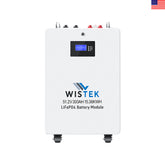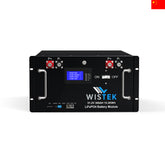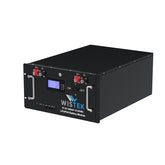A Complete Overview of 48V Batteries and Their Voltage and Capacity
In the evolving landscape of energy storage and power systems, the 48V battery has emerged as a pivotal component across various industries. From renewable energy applications to electric vehicles and industrial equipment, understanding the intricacies of 48V batteries is essential for optimizing performance and ensuring safety. This comprehensive guide delves into the voltage levels, capacity considerations, and practical applications of 48V batteries, providing valuable insights for both professionals and enthusiasts.
- Understanding the Basics of 48V Battery Systems
- Voltage Levels in 48V Battery Systems
- Capacity Considerations in 48V Batteries
- Applications of 48V Battery Systems
- Advantages of 48V Battery Systems
- Selecting the Right 48V Battery
- Maintenance and Safety Tips for 48V Battery Systems
Understanding the Basics of 48V Battery Systems
What Defines a 48V Battery?
A 48V battery system typically consists of multiple cells connected in series to achieve a nominal voltage of 48 volts. This configuration strikes a balance between power output and safety, making it suitable for a wide range of applications. The actual voltage can vary based on the battery's state of charge (SOC) and the specific chemistry used.
Common Chemistries in 48V Batteries
The most prevalent chemistries in 48V batteries include:
Lithium Iron Phosphate (LiFePO₄): Known for its thermal stability, long cycle life, and safety features.
Lithium-Ion (Li-ion): Offers high energy density and efficiency but requires careful management to prevent thermal runaway.
Lead-Acid: Traditional technology with lower energy density and shorter cycle life compared to lithium-based batteries.
>>See also BCI Battery Group Size Chart and Quick Reference Guide
Voltage Levels in 48V Battery Systems
Charging and Discharging Parameters
Understanding the voltage levels during charging and discharging is crucial for maintaining battery health and performance.
Fully Charged Voltage: Approximately 54.4V to 58.4V, depending on the chemistry.
Nominal Voltage: Typically around 51.2V.
Discharged Voltage: Can drop to about 40V, which is often considered the cutoff to prevent deep discharge.
For instance, a 48V LiFePO₄ battery has a fully charged voltage of about 58.4V and a nominal voltage of 51.2V.
State of Charge (SOC) and Voltage Correlation
The SOC of a battery indicates the remaining capacity and is closely tied to its voltage. Here's a general correlation for a 48V LiFePO₄ battery:
100% SOC: ~58.4V
80% SOC: ~53.1V
50% SOC: ~51.2V
20% SOC: ~48.0V
Monitoring these levels helps in optimizing battery usage and longevity.
Capacity Considerations in 48V Batteries
Measuring Battery Capacity
Battery capacity is typically measured in ampere-hours (Ah) or kilowatt-hours (kWh). For example, a 48V battery with a capacity of 100Ah stores 4.8kWh of energy (48V x 100Ah = 4,800Wh or 4.8kWh).
Factors Affecting Capacity
Several factors influence the actual usable capacity of a 48V battery:
Depth of Discharge (DoD): Refers to the percentage of the battery that has been discharged relative to its total capacity. Deeper discharges can reduce battery lifespan.
Temperature: Extreme temperatures can affect battery performance and capacity.
Age and Usage Patterns: Over time, batteries naturally degrade, leading to reduced capacity.
Implementing proper battery management systems (BMS) can help mitigate these factors and extend battery life.
Applications of 48V Battery Systems
Renewable Energy Storage
48V batteries are widely used in solar and wind energy systems for storing generated power. Their compatibility with inverters and charge controllers makes them ideal for off-grid and backup power applications.
Electric Vehicles (EVs)
In EVs, 48V battery systems support functions like start-stop operations, regenerative braking, and powering auxiliary systems. They offer a balance between performance and safety, especially in mild hybrid vehicles.
Industrial and Commercial Use
Industries utilize 48V batteries for powering equipment, backup systems, and uninterruptible power supplies (UPS). Their reliability and efficiency make them suitable for critical applications.
Advantages of 48V Battery Systems
Enhanced Safety: Operating below 60V reduces the risk of electric shock, aligning with Safety Extra Low Voltage (SELV) standards.
Improved Efficiency: Higher voltage systems can deliver the same power with lower current, reducing losses due to resistance.
Scalability: Modular design allows for easy scaling to meet varying power requirements.
Longer Lifespan: Especially in lithium-based batteries, proper management can lead to thousands of charge-discharge cycles.
>>See also Choosing Between Carbon Zinc and Alkaline Batteries A Complete Guide
Selecting the Right 48V Battery
When choosing a 48V battery system, consider the following:
Application Requirements: Determine the power and energy needs of your specific application.
Battery Chemistry: Choose between LiFePO₄, Li-ion, or lead-acid based on performance, cost, and safety considerations.
Capacity Needs: Ensure the battery has sufficient capacity (Ah or kWh) to meet your energy demands.
Environmental Conditions: Consider temperature ranges and other environmental factors that may affect battery performance.
Budget Constraints: Balance initial investment with long-term operational costs and maintenance.
Maintenance and Safety Tips
Regular Monitoring: Keep an eye on voltage levels and SOC to prevent overcharging or deep discharging.
Temperature Management: Ensure batteries operate within recommended temperature ranges to avoid degradation.
Proper Storage: Store batteries in a cool, dry place when not in use.
Use of BMS: Implement battery management systems to monitor and control charging, discharging, and overall health.
Safety Precautions: Follow manufacturer guidelines for installation, usage, and disposal to ensure safety.
In conclusion, the 48V battery stands as a versatile and efficient solution across various sectors, from renewable energy to transportation and industrial applications. Understanding its voltage characteristics, capacity considerations, and maintenance requirements is crucial for optimizing performance and ensuring longevity. As technology advances, the role of 48V batteries is poised to become even more significant in our pursuit of sustainable and reliable energy solutions.



















Leave a comment
All blog comments are checked prior to publishing